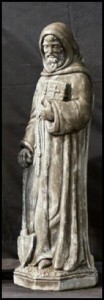And the Lord God planted a garden in Eden, in the east; and there he put the man whom he had formed. [Gen. 2:8]
Holy Scripture abounds in references to gardens, beginning with that most perfect garden, Eden, where men still “walked with God.” Our Savior spent the last night before his death in the Garden of Gethsemane and was crucified and buried in a garden. Now in the place where he was crucified there was a garden. [John 19:41]
Jesus’ parables are also full of references to planting, weeding, and harvesting. It is obvious that God has intended for his people to be connected to this fruitful earth and to make use of its bounty.
Historically, monasteries have had a special vocation for planting and tending gardens. After the first monks had fled to the Egyptian desert to live in solitude, and monasticism spread to the West, most monastics began to live in community with others and in harmony with their surroundings.
St. Benedict, in the early 6th century, established a “rule” which soon became the norm for most Western monastic houses. This rule required, in addition to prayer and study, useful work of some kind and this always included farming (or gardening) to help provide food for the monastery. In the next century, an Irish hermit became so associated with the art of gardening that he is known as the patron saint of gardeners.
Fiacre is believed to have been the son of an Irish chieftain, the leader of a large “tuath” or settlement populated by an extended family – a clan. His father wanted him to join in leading the clan, but Fiacre desired nothing more than to live a quiet life of prayer and fasting in solitude. He had received his education at a monastery and preferred the life that monks led to that of going to war against rival clans.
After several years of life on the banks of the Nore River, where he lived in a cave near a well with a garden for food, Fiacre had acquired a number of followers. Many came to him for words of wisdom or for herbs for physical ailments and some stayed to share in this quiet life. So, like many others, Fiacre left his hermitage and pursued solitude in exile from his homeland. Journeying to the continent, he settled near Meaux (south of Paris) around 626.
Fiacre asked the bishop for a plot of land to till to sustain himself, and Bishop Faro offered him as much land as he could “turn over” in one day. A miracle then occurred which was a sign of the plans that God had for this lowly monk. As Fiacre moved around the land, carrying his shovel and examining the soil, trees and shrubs fell over and the ground turned over by itself, ready to be planted, providing the monk with a large farm suitable for many more inhabitants than one solitary hermit.
It did not take long for word to spread about this monk and his gift of miracles. His holiness of living was also noticed and once again many other men came to follow him in this life. Fiacre had to establish a monastery with a pattern of work, study and prayer for the monks. With wood from the trees which fell and stones from his land, he built a chapel dedicated to the Mother of God. He soon added an infirmary for the many sick who came for help and he built a hospice for travelers, especially poor pilgrims from his native Ireland.
Abbot Fiacre remained in charge of the gardens. This was the work he loved the most and it was the vehicle for his gift of healing. People came from great distances to receive tonics and salves – as well as prayers – from Fiacre, and many miraculous healings resulted. The abbot used very ordinary herbs and plants and, through the healing power of the Holy Spirit, was able to ease the suffering of many people.
Even after his death around 670, St. Fiacre’s gardens flourished and throughout the centuries since that time, miracles of healing have been attributed to his intercession. Because carriages could be hired to take people from the Hôtel Saint-Fiacre in Paris out to his shrine, the name fiacre eventually came to be applied to the carriages themselves. The name is still used for taxi-cabs in France and taxi drivers have also adopted the saint as their patron.
St. Fiacre provides us with an example of how we are to use whatever gifts God has given us to help others and a reminder to rejoice in the beauty and bounty which God has provided in the gardens of this world. We give thanks for the fruits of the earth and we implore the intercessions of St. Fiacre for the healing of bodily infirmities.
